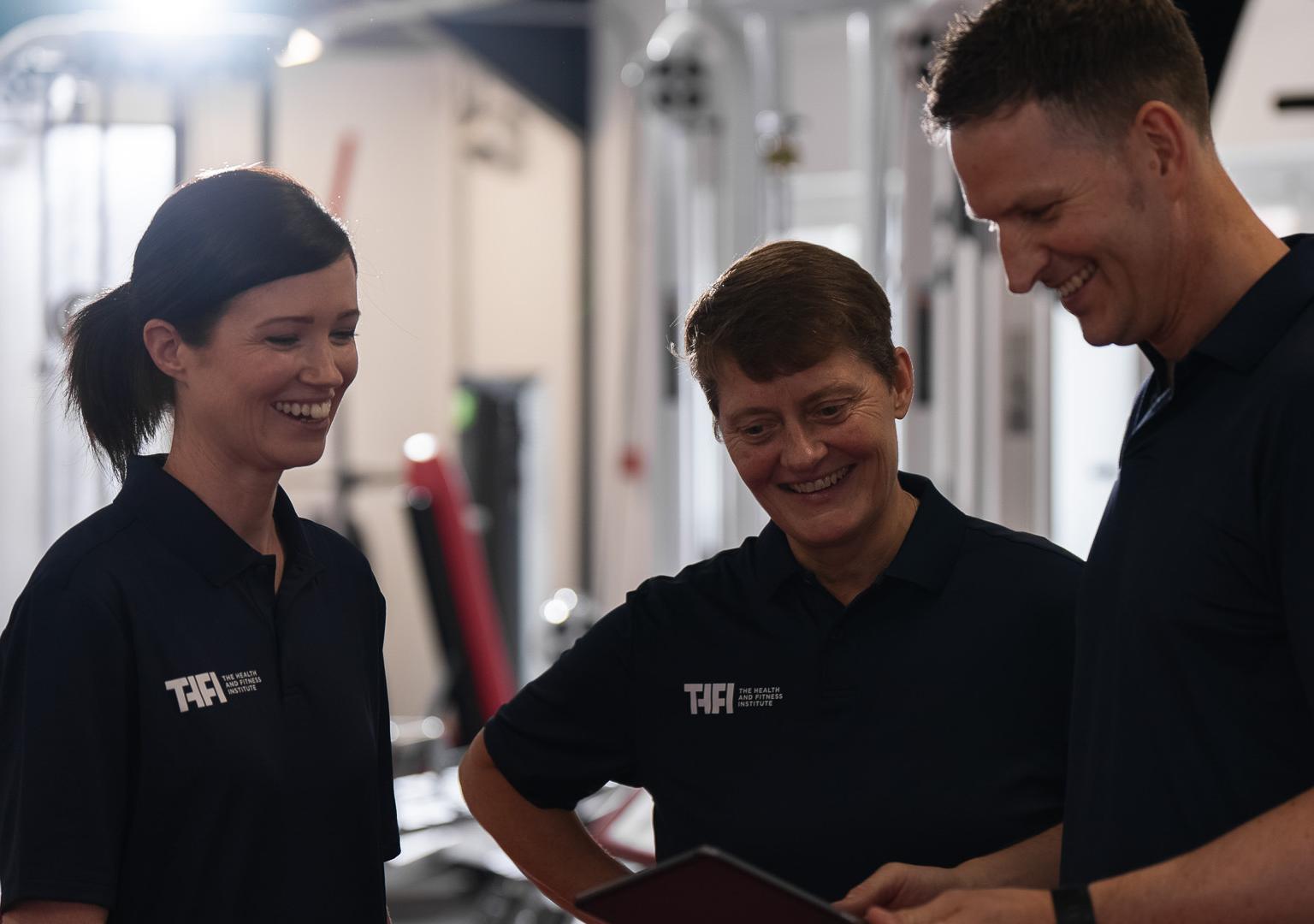How Much Do Personal Trainers Earn?

How much money do personal trainers earn? The answer is ‘it depends...’
The fitness industry is booming right now with huge scope for personal trainers to earn big money.
While Glassdoor report that the average salary for a personal trainer in the UK is £27,965 there is a huge amount of variation within this.
This article breaks it all down for you – looking at how certification, experience level, and your chosen work environment impact your earnings (and how you can leverage these factors to your advantage).
You’ll see what entry-level, mid-career, and veteran trainers typically earn and what influences these figures.
You’ll learn how different training setups – from one-to-one, group classes, or online PT – can maximise your income.
And you’ll see different ways to enhance your specialisation and use technology to expand your reach and efficiency.
Here’s everything you need to know about the money personal trainers can make and how to increase your own earning potential...
What Factors Determine a Personal Trainer's Income?
There’s no single answer to how much a personal trainer can earn. A PT’s income can vary significantly depending on a number of factors – not just how much job experience you have working with clients.
But how you work, the business model you follow, the skills you have, and where you’re located can all have a bearing on how much you bank each month. Understanding these factors can help you navigate your career path more strategically and maxmise your earning potential.
Certification and Education
In the realm of personal training, your qualifications can significantly influence your earnings. A Level 3 Certificate in Personal Training is the basic requirement to practice in the UK, but trainers who invest in further qualifications, such as Level 4 specialisms like Level 4 Strength and Conditioning Coaching or degrees in sports science, often command higher fees. Continuous professional development can set you apart, not only enhancing your expertise but also elevating your marketability and thus your earning potential.
Experience Level
Like many professions, experience in personal training has a direct correlation with income. Beginners in the field may start with lower earnings, with the average entry-level salary being around £18,000 according to Glassdoor. But as you gain more experience, your ability to attract and retain clients improves, boosting your income. Experienced trainers can also leverage their track record of success to command higher rates, negotiate better terms within gyms, or expand into lucrative areas such as online coaching or personalised high-end training services.
Location and Market
Where you choose to work plays a crucial role in how much you can earn as a personal trainer. Major cities like London or Manchester typically offer higher earning potential due to a larger client base and a willingness among those clients to invest more money in health and fitness. The average PT salary in London is £34,059, and in Manchester, it’s £30,347, according to job site Indeed.
However, the cost of living, business overheads and competition in these areas can also be higher. In contrast, trainers in smaller towns or rural areas may face less competition but will also likely encounter lower demand and pricing limitations. The average salary in Carlisle is £19,136, and in Exeter it’s £22,733, according to Indeed.
Working Environment
The setting in which you choose to train clients can affect your earnings. Gym-employed personal trainers often receive a stable income but may earn less per hour compared to their self-employed counterparts, who can set their own rates and terms.
However, self-employed trainers bear more risk and must cover their own equipment and insurance costs. Additionally, the rise of online personal training has opened new avenues for trainers to reach a global client base without the overhead costs associated with physical locations. This model not only offers flexibility but also the potential for a higher profit margin, as you can offer a mix of live sessions and pre-packaged workout plans.
Remember – understanding the dynamics of the personal training industry will enable you to strategically steer your career towards higher earnings and greater success.
Pure Gym – £25,000 average salary
Virgin Active – £30,000 average salary
Ultimate Performance – £36,000 average salary (inc bonuses)
Average Income Statistics: How Much Do Personal Trainers Really Make?
Personal training can be a financially rewarding career, but the income spectrum is broad. Earnings vary widely based on factors such as qualification levels, experience, and geographical location. Here’s what you can typically expect across different stages of a personal training career:
Entry-Level Trainers
Newcomers to the industry often start their careers in gym settings, which provides a stable environment to build skills and client relationships. According to industry reports and job postings, entry-level personal trainers in the UK can expect to earn between £14,000 and £20,000 per year. These figures can be influenced by the number of clients, session rates, and the type of employment contract. Many start part-time while building a client base and can supplement their income with group classes or additional fitness-related roles.
Mid-Career Trainers
With a few years of experience, personal trainers can significantly increase their earning potential. Mid-career personal trainers, typically with 3 to 5 years of experience, often see their earnings rise to between £20,000 and £35,000 annually. At this stage, trainers usually have a steady clientele and may also offer specialised services, which allow for higher session charges. Some may also take on managerial roles within gyms or start their own training businesses, further enhancing their income.
Veteran Trainers
For those who have dedicated a significant part of their careers to personal training, the financial rewards can be substantial. Veteran personal trainers, with over 10 years of experience, can earn upwards of £35,000 to £60,000. The top earners can pocket anything up to £100,000 annually. These trainers have often established a strong personal brand, command high rates for one-on-one sessions, and may run their own fitness studios or online training platforms. They also often expand into related fields such as wellness coaching, public speaking, and fitness writing, all of which contribute to a higher income.
The figures mentioned offer a general guide and should serve as benchmarks. Remember, the key to advancing in this field lies not only in building experience but also in continuously enhancing your skills and adapting to market needs. Whether you are just starting out or looking to scale new heights in your fitness career, understanding these income levels can help you set realistic financial goals and strategise your career development effectively.
A Closer Look at Different Training Modalities
The way you choose to deliver your training services can significantly impact your earning potential. Each modality offers unique advantages and challenges, and understanding these can help you optimise your approach to maximise your income.
One-to-One Personal Training
One-to-one personal training remains the most traditional and personalised approach in the industry. This modality allows trainers to charge premium rates per session due to the tailored attention and customised workout plans provided to clients. In the UK, personal trainers can typically charge anywhere from £30 to £65 per hour, depending on their location, expertise, and reputation. High-demand areas like central London may see even higher rates. This modality's income is directly proportional to the number of sessions a trainer can book and sustain over time.
Group Exercise Instruction
Leading group exercise classes or bootcamps is a popular way to increase earnings by servicing multiple clients simultaneously. While the rate per individual might be lower than one-to-one sessions – commonly between £5 to £20 per person – the overall income per session can be quite substantial if the class size is large. For example, a bootcamp class with 20 participants at £10 per head generates £200 per session, potentially far exceeding the hour-rate of individual training. This modality not only increases hourly earnings but also helps in reaching a broader client base, which can lead to further one-to-one training opportunities.
Online Personal Training
The digital revolution has introduced online personal training as a viable and increasingly popular modality among fitness professionals. This approach allows trainers to conduct sessions via video platforms, create and sell digital training programs, or offer subscription-based content. While the rates for live online sessions might be slightly less than in-person sessions, the ability to transcend geographical boundaries opens up a vast potential client base. Additionally, selling digital products such as workout plans or diet guides provides a scalable way to earn passive income beyond direct client interactions. Trainers can set up subscription models ranging from £10 to £100 per month, depending on the comprehensiveness and exclusivity of the content provided.
Each training modality offers distinct pathways to increase your income and expand your business. Whether you prefer the personal touch of one-on-one sessions, the dynamic energy of group classes, or the innovative reach of online platforms, leveraging the right mix tailored to your strengths and market demand can significantly boost your financial success as a personal trainer.
Freelance trainers vs salaried trainers
Both freelance and salaried roles present distinct advantages and challenges. Freelancers enjoy greater autonomy and potentially higher earnings but face variable income and higher personal overheads. In contrast, salaried trainers benefit from stable income and fewer personal expenses but may experience restrictions in earnings growth and work flexibility. Personal trainers must consider these aspects carefully to choose a path that aligns best with their career goals, financial needs, and preferred working style.
Freelance Personal Trainers
Freelance personal trainers have the advantage of setting their own schedules and rates, which can significantly influence their earning potential. Typically, they can charge anywhere between £30 and £65 per hour, depending on factors such as location, expertise, and the specific demands of their clientele. The financial success of a freelancer hinges on their ability to effectively acquire and retain a stable client base. Freelancers also benefit from the flexibility to adapt their pricing strategy based on the current market demand and their unique value proposition, particularly if they target niche markets like sports performance or weight loss, allowing them to command premium rates. However, they must manage overhead costs such as equipment, travel, and potentially renting training spaces, which are crucial for maximising profitability.
Salaried Personal Trainers
Salaried personal trainers typically enjoy more predictable income streams, with annual salaries ranging from £14,000 to £30,000. These positions often come with additional perks such as performance-related bonuses or commissions for client sign-ups. The base salary in these roles is usually determined by the employer and can vary depending on the trainer's experience and qualifications. Additional job benefits like health insurance, pension contributions, and paid holidays can make these roles financially appealing. Salaried positions also offer potential career advancement within the fitness centre or gym, which could lead to higher earnings.
However, trainers in these roles often face limitations such as fixed working hours set by their employer, which may restrict the potential for additional income. They also have less control over session pricing, which can cap their earning potential compared to their freelance counterparts.
Enhancing Your Earning Potential
As a personal trainer, your ability to increase your income isn't just about the hours you work – it's about how strategically you can position yourself in the market. By focusing on specialisation, client relationships, and the use of technology, you can significantly enhance your earning potential. Let's explore these avenues in more detail.
Specialisation and Niche Markets
Diving into a specialisation or niche market can substantially increase your value as a personal trainer. By becoming an expert in a specific area such as rehabilitation, sports performance, or luxury fitness, you differentiate yourself from competitors and can charge premium rates. For instance, trainers who specialise in post-injury recovery can work closely with healthcare providers and receive referrals, thereby tapping into a market that values highly specialised knowledge. Similarly, those focusing on sports performance might work with athletes who seek out the best trainers to enhance their competitive edge, commanding higher fees for their specialized services. Luxury fitness trainers, offering bespoke services to high-net-worth individuals, can also see significantly higher earnings, especially in affluent areas.
Building a Strong Client Base
Your clients are the cornerstone of your business, and building a strong, loyal client base is crucial for sustained income growth. Effective marketing strategies – like targeted social media advertising, networking with health professionals, and leveraging client testimonials – can attract new clients. However, retaining them requires excellent service, consistent results, and building a personal connection. Implementing a referral program can be particularly effective, as word-of-mouth from satisfied clients is often the best endorsement. Additionally, offering flexible package deals or loyalty discounts encourages long-term commitments and repeat business, stabilising your income.
Leveraging Technology
In today's digital age, embracing technology can significantly expand your reach and streamline your business operations. Establishing a strong online presence through a professional website and active social media accounts can attract clients from beyond your local area. Utilising online training platforms allows you to host virtual training sessions and reach clients globally. Moreover, developing downloadable content such as fitness videos, eBooks, or nutrition plans can provide additional revenue streams. Tools like client management software can also enhance your efficiency by automating bookings, reminders, and payments, allowing you more time to focus on client service and acquisition.
Conclusion
It's clear that qualifications, experience, and the choice of training modality play pivotal roles in determining earnings. Entry-level trainers might start with modest incomes, but there is significant scope for growth. Mid-career trainers see a notable increase in earnings as they gain experience and refine their expertise, while veteran trainers can achieve substantial incomes through specialization and reputation. Additionally, the setting—whether in-person, group, or online—also impacts the potential earnings, with each offering unique opportunities for financial growth.
As you continue on your journey as a personal trainer, it’s essential to set clear financial goals and adopt a strategic approach to your career development. Continuously upgrade your skills and qualifications to stay competitive and relevant in this ever-evolving industry. Consider specialising in niche markets that not only interest you but also offer the potential for higher earnings. Embrace technology, not just for marketing and client management, but also to expand your service offerings into the digital realm.








